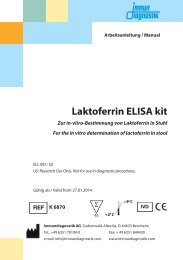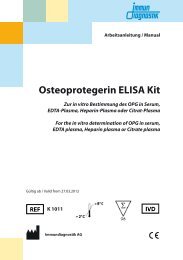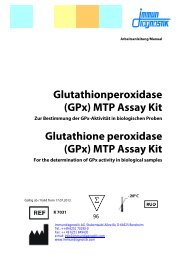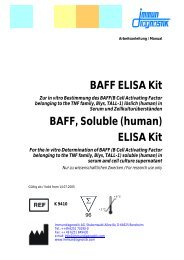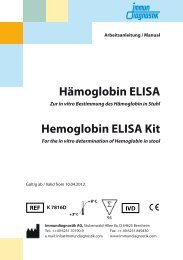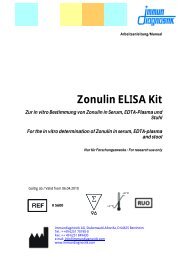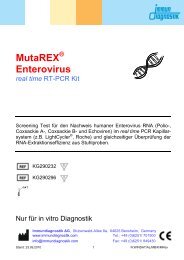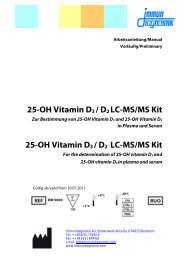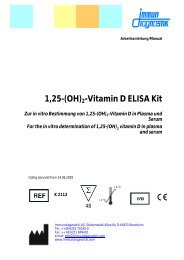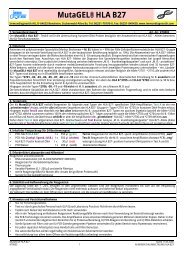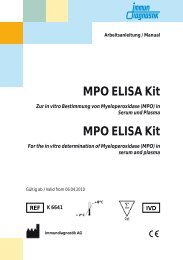HPLC-Analytik Homocystein - bei Immundiagnostik
HPLC-Analytik Homocystein - bei Immundiagnostik
HPLC-Analytik Homocystein - bei Immundiagnostik
Sie wollen auch ein ePaper? Erhöhen Sie die Reichweite Ihrer Titel.
YUMPU macht aus Druck-PDFs automatisch weboptimierte ePaper, die Google liebt.
100<br />
Ar<strong>bei</strong>tsanleitung/Manual<br />
<strong>Homocystein</strong> <strong>HPLC</strong> Kit<br />
Zur Bestimmung von <strong>Homocystein</strong> in Plasma und Serum<br />
<strong>Homocystein</strong>e <strong>HPLC</strong> Kit<br />
For the determination of <strong>Homocystein</strong>e in plasma and serum<br />
Gültig ab / Valid from 18.08.2010<br />
KC 2801<br />
<strong>Immundiagnostik</strong> AG, Stubenwald-Allee 8a, D 64625 Bensheim<br />
Tel.: ++49 6251 70190-0<br />
Fax: ++ 49 6251 849430<br />
e.mail: Info@immundiagnostik.com<br />
www.<strong>Immundiagnostik</strong>.com
<strong>HPLC</strong>-<strong>Analytik</strong> <strong>Homocystein</strong><br />
Inhaltsverzeichnis/Table of contents Seite/Page<br />
1. VERWENDUNGSZWECK 3<br />
2. EINLEITUNG 3<br />
3. TESTPRINZIP 3<br />
4. INHALT DER TESTPACKUNG 4<br />
5. ERFORDERLICHE LABORGERÄTE UND HILFSMITTEL 4<br />
6. VORBEREITUNG UND LAGERUNG DER REAGENZIEN 5<br />
7. HINWEISE UND VORSICHTSMASSNAHMEN 6<br />
8. PROBENVORBEREITUNG 6<br />
9. TESTDURCHFÜHRUNG 6<br />
HINWEISE 6<br />
ARBEITSSCHEMA 7<br />
CHROMATOGRAPHISCHE BEDINGUNGEN 7<br />
10. BEHANDLUNG DER TRENNSÄULE 8<br />
11. AUSWERTUNG 8<br />
BERECHNUNG 8<br />
MUSTERCHROMATOGRAMM 8<br />
12. EINSCHRÄNKUNGEN 9<br />
13. QUALITÄTSKONTROLLE 9<br />
NORMBEREICH 9<br />
KONTROLLEN 9<br />
14. TESTCHARAKTERISTIKA 10<br />
PRÄZISION UND REPRODUZIERBARKEIT 10<br />
LINEARITÄT 10<br />
NACHWEISGRENZE 10<br />
WIEDERFINDUNG 10<br />
15. ENTSORGUNG 10<br />
16. MASSNAHMEN BEI STÖRUNGEN 11<br />
17. LITERATUR 12<br />
18. ALLGEMEINE HINWEISE ZUM TEST 12<br />
1
<strong>HPLC</strong>-<strong>Analytik</strong> <strong>Homocystein</strong><br />
1. INTENDED USE 14<br />
2. SUMMARY AND EXPLANATION OF THE TEST 14<br />
3. PRINCIPLE OF THE TEST 14<br />
4. MATERIAL SUPPLIED 15<br />
5. MATERIAL REQUIRED BUT NOT SUPPLIED 16<br />
6. PREPARATION AND STORAGE OF REAGENTS 16<br />
7. PRECAUTIONS 17<br />
8. SPECIMEN COLLECTION AND PREPARATION 17<br />
9. ASSAY PROCEDURE 17<br />
PROCEDURAL NOTES 17<br />
SAMPLE AND STANDARD PREPARATION 18<br />
CHROMATOGRAPHIC CONDITIONS 18<br />
10. TREATMENT OF THE COLUMN 19<br />
11. RESULTS 19<br />
CALCULATION 19<br />
TYPICAL CHROMATOGRAM 19<br />
12. LIMITATIONS 20<br />
13. QUALITY CONTROL 20<br />
EXPECTED VALUES 20<br />
CONTROLS 20<br />
14. PERFORMANCE CHARACTERISTICS 21<br />
PRECISION AND REPRODUCIBILITY 21<br />
LINEARITY 21<br />
DETECTION LIMIT 21<br />
RECOVERY 21<br />
15. DISPOSAL 21<br />
16. TROUBLESHOOTING 22<br />
17. REFERENCES 23<br />
18. GENERAL NOTES ON THE TEST AND TEST PROCEDURE 23<br />
2
<strong>HPLC</strong>-<strong>Analytik</strong> <strong>Homocystein</strong><br />
1. VERWENDUNGSZWECK<br />
Die <strong>HPLC</strong>-Applikation ist für die Bestimmung von <strong>Homocystein</strong> aus Plasma<br />
und Serum geeignet. Nur zur in vitro Diagnostik.<br />
2. EINLEITUNG<br />
<strong>Homocystein</strong> kommt im Plasma in freier Form und zu ca. 70% an Albumin<br />
gebunden vor. Methionin wird nach einigen Stoffwechselschritten zunächst<br />
umgewandelt in <strong>Homocystein</strong>, dies wird mit Hilfe der Cystathion-Beta-<br />
Synthase (Cofaktor Vitamin B6) weiter umgewandelt zu Cystin und danach<br />
abgebaut. Bei einem Mangel des Enzyms steigen die Konzentrationen an<br />
Methionin und <strong>Homocystein</strong> an, die von Cystin nimmt ab. Daraus resultiert<br />
die <strong>Homocystein</strong>urie, die unbehandelt zu psychomotorischen<br />
Behinderungen führt.<br />
Neuere Ergebnisse zeigen, daß <strong>Homocystein</strong> ein wichtiger Risikofaktor für<br />
koronare Arterienerkrankungen ist. Hohe Werte findet man gehäuft <strong>bei</strong><br />
Menschen mit einem genetischen Defekt im Eiweißstoffwechsel, das<br />
<strong>Homocystein</strong> wird nicht abgebaut. Untersuchungen zu Folge, ist dies die<br />
Ursache für 40% aller Herzinfarktfälle in den USA. Außerdem steigt das<br />
Risiko eines Schlaganfalles proportional mit der Konzentration von<br />
<strong>Homocystein</strong> im Blut.<br />
Mit den Vitaminen B6, B12 und Folsäure kann der erhöhte Plasma-<strong>Homocystein</strong>spiegel<br />
wirksam und ohne Nebenwirkungen gesenkt werden.<br />
3. TESTPRINZIP<br />
Zur Bestimmung des <strong>Homocystein</strong>s wird im ersten Schritt eine<br />
Probenvorbereitung mit angeschlossener Derivatisierung durchgeführt. Den<br />
Plasma- bzw. Serumproben wird der interne Standard zugegeben und die<br />
Proben werden in einem Schritt einer Reduktion und einer Derivatisierung<br />
unterzogen. Hier<strong>bei</strong> wird das noch an Albumin gebundene <strong>Homocystein</strong><br />
freigesetzt, sowie Homocystin in zwei <strong>Homocystein</strong>e gespalten. In der<br />
Derivatisierungsreaktion erfolgt die Umsetzung des <strong>Homocystein</strong>s in ein<br />
fluoreszierendes Produkt. Danach erfolgt in einem Fällungsschritt die<br />
Abtrennung höher molekularer Substanzen.<br />
Die Trennung mittels <strong>HPLC</strong> erfolgt in einem isokratischen Verfahren <strong>bei</strong><br />
30 °C auf einer "reversed phase" Säule. Die Aufnahme der Chromatogramme<br />
erfolgt mit einem Fluoreszensdetektor. Die Trennung benötigt ca. 5 Minuten<br />
für einen Lauf. Die Quantifizierung erfolgt über den mitgelieferten Plasma-<br />
Kalibrator und die Berechnung der Ergebnisse wird über die "interne<br />
Standard-Methode" anhand der Integration der Peakfläche durchgeführt.<br />
3
<strong>HPLC</strong>-<strong>Analytik</strong> <strong>Homocystein</strong><br />
Zusammenfassung<br />
Der hier vorliegende Komplettkit zur Bestimmung des <strong>Homocystein</strong>s<br />
ermöglicht eine einfache, schnelle und präzise quantitative Bestimmung.<br />
Dieser Komplettkit enthält gebrauchsfertig alle Reagenzien und<br />
Verbrauchsmaterialien für die Aufbereitung der Proben und die analytische<br />
<strong>HPLC</strong>-Trennung.<br />
Wie auch <strong>bei</strong> vielen anderen Parametern liegt der Vorteil der <strong>HPLC</strong>-<strong>Analytik</strong><br />
in der gleichzeitigen Abar<strong>bei</strong>tung vieler Analyten in einem Test. Die <strong>HPLC</strong>-<br />
System-Komplettlösung ermöglicht auch Laboratorien, die bislang noch<br />
keine Erfahrung mit Hochdruckflüssigkeitschromatographie haben, diese<br />
Technik schnell und problemlos für klinisch-chemische Routinezwecke<br />
einzusetzen. Für die Kalibrierung des Testsystems ist eine Einpunkt-<br />
Kalibrierung ausreichend, im Gegensatz von Immunoassays bis zu 6<br />
Kalibratoren pro Testansatz. Eine Automatisierung der Probenaufgabe und<br />
der Auswertung ist möglich, sodass auch größere Probenzahlen fast<br />
unbeaufsichtigt abgear<strong>bei</strong>tet werden können. (Bei kurzen Serienlängen ist<br />
die Einpunktkalibrierung sehr viel wirtschaftlicher gegenüber der 6-Punkt-<br />
Kalibrierung <strong>bei</strong> Immuno-Assays).<br />
4. INHALT DER TESTPACKUNG<br />
Artikel Nr. Inhalt Kit Komponenten Menge<br />
KC2801LM MOPHA Laufmittel 1 x 1000 ml<br />
KC2801KA CAL Kalibrator (lyoph., 1 ml;<br />
Konzentration siehe Etikett)<br />
4<br />
1 Fläschchen<br />
KC2801IS INT STD interner Standard (lyoph., 12 ml) 1 Fläschchen<br />
KC2801RE RECSOL Rekonstitutionslösung 1 x 25 ml<br />
KC2801RL REDSOL Reduktionslösung (lyoph., 2,4 ml) 1 Fläschchen<br />
KC2801DL DER Derivatisierungslösung 1 x 12 ml<br />
KC2801FR PREC Fällungsreagenz 1 x 12 ml<br />
KC 2801KO CTRL 1<br />
CTRL 2<br />
Kontrolle 1 und 2 (lyoph., 250 µl;<br />
Konzentration siehe Spezifikation)<br />
2 x 3<br />
Fläschchen<br />
Die <strong>HPLC</strong> Trennsäule (KC 2801RP) kann separat <strong>bei</strong> <strong>Immundiagnostik</strong> bestellt<br />
werden. Neben den kompletten Kits können auch alle Komponenten einzeln<br />
bestellt werden. Bitte fordern Sie unsere Einzelkomponentenpreisliste an.
<strong>HPLC</strong>-<strong>Analytik</strong> <strong>Homocystein</strong><br />
5. ERFORDERLICHE LABORGERÄTE UND HILFSMITTEL<br />
• 1,5 ml Reaktionsgefäße (z.B. Eppendorf)<br />
• Zentrifuge<br />
• Wasserbad / heizbarer Schüttler<br />
• div. Pipetten<br />
• <strong>HPLC</strong> Gerät mit Fluoreszens-Detektor<br />
• reversed phase C18-Säule<br />
• Vortex Wirbelmischer<br />
6. VORBEREITUNG UND LAGERUNG DER REAGENZIEN<br />
• Die Testreagenzien sind <strong>bei</strong> 2-8 °C, der Kalibrator (CAL), der interne<br />
Standard (INT STD) und die Kontrollen (CTRL) <strong>bei</strong> -20 °C bis zum Verfallsdatum<br />
(siehe Etikett) verwendbar.<br />
• Der Kalibrator (CAL) wird in 1 ml und der interne Standard (INT STD) in<br />
12 ml der mitgelieferten Rekonstitutionslösung (RECSOL) resuspendiert.<br />
Kalibrator und interner Standard werden anschließend aliquotiert und <strong>bei</strong><br />
–20 °C gelagert. Der Gehalt an <strong>Homocystein</strong> ändert sich geringfügig von<br />
Charge zu Charge, der genaue Gehalt ist auf dem Etikett angegeben.<br />
• Die Kontrollen (CTRL1,2) werden in 250 µl Rekonstitutionslösung (RECSOL)<br />
gelöst.<br />
• Die lyophilisierte Reduktionslösung (REDSOL) wird mit 2,4 ml Rekonstitutionslösung<br />
(RECSOL) versetzt und ist dann <strong>bei</strong> 2-8 °C 3 Monate haltbar.<br />
5
<strong>HPLC</strong>-<strong>Analytik</strong> <strong>Homocystein</strong><br />
7. HINWEISE UND VORSICHTSMASSNAHMEN<br />
• Standards und Kontrollen sind auf Humanplasma aufgebaut. Sie sind auf<br />
HIV und Hepatitis B getestet und für negativ befundet worden. Jedoch<br />
sollten die Testkomponenten als Vorsichtsmaßnahme immer wie<br />
potentiell infektiöses Material behandelt werden.<br />
• Das Fällungsreagenz besteht aus Säure und muss mit Vorsicht behandelt<br />
werden. Sie verursacht <strong>bei</strong> Kontakt mit der Haut Verätzungen. Es sollte<br />
daher mit Schutzhandschuhen und Schutzbrille gear<strong>bei</strong>tet werden. Bei<br />
Kontakt mit der Säure muss die verätzte Stelle sofort mit viel Wasser<br />
gespült werden.<br />
• Die Reagenzien dürfen nach Ablauf des Mindesthaltbarkeitsdatums nicht<br />
mehr verwendet werden.<br />
8. PROBENVORBEREITUNG<br />
Als Patientenprobe ist EDTA-Plasma zu bevorzugen, da es <strong>bei</strong> Serumproben<br />
zu einem zeitabhängigen Anstieg des <strong>Homocystein</strong>gehaltes kommen kann.<br />
Die Probe sollte in jedem Fall sofort nach der Abnahme kühl gelagert<br />
werden, und innerhalb der nächsten 30 Minuten <strong>bei</strong> 2000 g in einer<br />
kühlbaren Zentrifuge für 10 min zentrifugiert werden. Danach kann die<br />
Probe <strong>bei</strong> 4°C gelagert werden. Für längere Lagerung (> 1 Woche) sollten<br />
die Proben <strong>bei</strong> -20 bis -80°C aufbewahrt werden.<br />
9. TESTDURCHFÜHRUNG<br />
Hinweise<br />
• Qualitätskontrollen sollten immer mitgemessen werden.<br />
• Inkubationszeit, Temperatur und Pipettiervolumina sind vom Hersteller<br />
festgelegt. Jegliche Abweichung der Testvorschrift, die nicht mit dem<br />
Hersteller koordiniert wurde, kann zu fehlerhaften Ergebnissen führen.<br />
<strong>Immundiagnostik</strong> übernimmt keine Haftung.<br />
• Der Assay ist immer nach der im Kit <strong>bei</strong>gefügten Ar<strong>bei</strong>tsanleitung<br />
abzuar<strong>bei</strong>ten.<br />
6
<strong>HPLC</strong>-<strong>Analytik</strong> <strong>Homocystein</strong><br />
Ar<strong>bei</strong>tsschema<br />
In 1,5 ml Reaktionsgefäße (z.B. Eppendorf) werden pipettiert:<br />
50 µl Patientenprobe, CAL (Kalibrator) oder CTRL 1, 2 (Kontrolle 1 und 2)<br />
+<br />
50 µl INT STD (Interner Standard)<br />
+<br />
20 µl REDSOL (Reduktionslösung)<br />
+<br />
100 µl DER (Derivatisierungslösung)<br />
mischen und 10 Minuten <strong>bei</strong> 60 °C reagieren lassen.<br />
Die Probe abkühlen und 100 µl PREC (Fällungsreagenz) zugeben,<br />
mischen, 5 Minuten <strong>bei</strong> 2-8 °C stehen lassen und anschließend für<br />
5 Minuten <strong>bei</strong> 10.000 g zentrifugieren. Die aufgear<strong>bei</strong>tete Probe ist <strong>bei</strong><br />
2-8 °C mindestens 6 Tage stabil.<br />
20 µl in das <strong>HPLC</strong>-System injizieren.<br />
Chromatographische Bedingungen<br />
Säulenmaterial: MZ Inertsil ODS-2; 5 µm<br />
MZ PerfectBond ODS-2; 5 µm<br />
Bischoff Prontosil Eurobond; 5 µm<br />
Säulendimension: 125 mm x 4 mm<br />
Fluß: 0,7 – 1,0 ml/min (der genaue Fluss ist auf der<br />
Produktspezifikation<br />
angegeben)<br />
der jeweiligen Säule<br />
Temperatur: 30 °C<br />
Detektion: Fluoreszensdetektion Exzitation: 385 nm<br />
Emission: 515 nm<br />
Auftragsvolumen: 20 µl<br />
Laufzeit: 5 Minuten<br />
Wir empfehlen die Verwendung einer Vorsäule um die Säulenhaltbarkeit<br />
zu verlängern.<br />
7
<strong>HPLC</strong>-<strong>Analytik</strong> <strong>Homocystein</strong><br />
10. BEHANDLUNG DER TRENNSÄULE<br />
Nach der Analyse sollte die Trennsäule mit ca. 30 ml Aqua bidest. <strong>bei</strong> einem<br />
Fluss von 1,0 ml/min gespült werden. Anschließend wird die Säule in 50%<br />
Methanol in Wasser gelagert (ca. 30 ml, Fluss 0,6 ml/min).<br />
Zur Wiederinbetriebnahme wird das ganze System mit ca. 30 ml MOPHA<br />
(Laufmittel) äquilibriert.<br />
11. AUSWERTUNG<br />
Berechnung<br />
Musterchromatogramm<br />
Volt<br />
0,2<br />
0,15<br />
0,1<br />
0,05<br />
0<br />
<strong>Homocystein</strong><br />
IS<br />
0 2 4 6 8 10<br />
Minuten<br />
8
<strong>HPLC</strong>-<strong>Analytik</strong> <strong>Homocystein</strong><br />
12. EINSCHRÄNKUNGEN<br />
Als Patientenprobe ist EDTA-Plasma zu bevorzugen, da es <strong>bei</strong> Serumproben<br />
zu einem zeitabhängigen Anstieg des <strong>Homocystein</strong>gehaltes kommen kann.<br />
13. QUALITÄTSKONTROLLE<br />
Normbereich<br />
(Aus "<strong>Homocystein</strong>" Resch, Till, Riezler, Pütter ISBN: 3-920328-17-5)<br />
< 15 Normalwert<br />
15 - 30 Durch Vitaminmangel bedingte<br />
Erhöhung<br />
31 - 100 Weist auf heterozygote <strong>Homocystein</strong>ämie<br />
hin<br />
> 100 Weist auf homozygote<br />
<strong>Homocystein</strong>ämie hin<br />
Nach einem Methioninbelastungstest kann die <strong>Homocystein</strong>konzentration<br />
ansteigen. Steigt sie jedoch über 30 µmol/l an, liegt eine heterozygote<br />
<strong>Homocystein</strong>ämie vor.<br />
Wir empfehlen, dass jedes Labor seinen eigenen Normalwerte-Bereich<br />
erstellt, weil Referenzbereiche stark von der Auswahl des Probandenkollektivs<br />
abhängig sind. Die Angabe des Normalbereichs dient lediglich<br />
der Orientierung und kann von anderen publizierten Daten abweichen.<br />
Kontrollen<br />
Zur Überwachung der Qualität der Analyse sollten <strong>bei</strong> jedem Lauf Kontrollen<br />
mitgeführt werden. Wenn eine oder mehrere Kontrollen eines Laufs<br />
außerhalb ihres Bereichs liegen ist es möglich, dass auch die Patientenproben<br />
falsch ermittelt wurden.<br />
9
<strong>HPLC</strong>-<strong>Analytik</strong> <strong>Homocystein</strong><br />
14. TESTCHARAKTERISTIKA<br />
Präzision und Reproduzierbarkeit<br />
Intra-Assay VK: 2,5 % (8,9 µmol/l) [n = 12]<br />
1,6 % (16,5 µmol/l) [n = 12]<br />
Inter-Assay VK: 5,2 % (8,7 µmol/l) [n = 12]<br />
2,9 % (17,4 µmol/l) [n = 12]<br />
Linearität<br />
Nachweisgrenze<br />
Wiederfindung<br />
15. ENTSORGUNG<br />
bis 500 µmol/l<br />
0,6 µmol/l<br />
98 %<br />
Das MOPHA (Laufmittel), REDSOL (Reduktionslösung), INT STD (interner<br />
Standard) und DER (Derivatisierungslösung) müssen als halogenfreier<br />
Lösungsmittelabfall entsorgt werden. Das PREC (Fällungsreagenz) kann mit<br />
Natronlauge neutralisiert und <strong>bei</strong> neutralem pH als Salzlösung entsorgt<br />
werden.<br />
Achtung: Wärmeentstehung!<br />
10
<strong>HPLC</strong>-<strong>Analytik</strong> <strong>Homocystein</strong><br />
16. MASSNAHMEN BEI STÖRUNGEN<br />
Problemstellung Mögliche Ursache Behebung<br />
Kein Signal Keine oder defekte<br />
Verbindung zur<br />
Auswerteeinheit.<br />
11<br />
Signalkabel und Anschluss<br />
prüfen.<br />
Detektorlampe zu alt Ggf. Lampe erneuern<br />
Keine Peaks Injektor verstopft Injektor überprüfen<br />
Doppelpeaks Totvolumen an<br />
Fittings und / oder<br />
Säule<br />
Fittings und / oder Säule<br />
erneuern<br />
Störpeaks Injektor verunreinigt Injektor reinigen<br />
Kontamination am<br />
Säulenkopf<br />
Säule umdrehen und 30 min<br />
mit niedrigem Fluß (0,2<br />
ml/min) Laufmittel spülen<br />
Luft im System Pumpe entgasen<br />
Autosamplergefäße<br />
verunreinigt<br />
Neue oder mit Methanol<br />
gespülte Autosamplergefäße<br />
verwenden<br />
Breite Peaks, Tailing Vorsäule / Säule zu alt Neue Vorsäule / Säule<br />
verwenden<br />
Veränderte<br />
Retentionszeit<br />
Temperaturdrift Säulenofen verwenden<br />
Pumpe fördert<br />
ungenau<br />
System noch nicht im<br />
Gleichgewicht<br />
Basislinie driftet Detektorlampe noch<br />
kalt<br />
Pumpe überprüfen, entlüften<br />
System mit mobiler Phase 15<br />
min spülen<br />
Warten<br />
Detektorlampe zu alt Ggf. Lampe erneuern<br />
System noch nicht im<br />
Gleichgewicht<br />
Pumpe fördert<br />
ungenau<br />
Unruhige Basislinie Pumpe fördert<br />
ungenau<br />
Detektorzelle<br />
verschmutzt<br />
System mit mobiler Phase 15<br />
min spülen<br />
Pumpe überprüfen, entlüften<br />
Pumpe überprüfen, entlüften<br />
Detektorzelle reinigen
<strong>HPLC</strong>-<strong>Analytik</strong> <strong>Homocystein</strong><br />
17. LITERATUR<br />
1. Role of Plasma Homocyst(e)ine in Arterial Occlusive Diseases. (1994)<br />
Clinical Chemistry, Vol. 40 No. 6, pp. 857-858.<br />
2. Association between Plasma homocysteine concentrations and<br />
extracranial carotid-artery stenosis. Selhub, J. et al. (1995). The New<br />
England Journal of Medicine, Feb. 95, Vol. 332 No. 5, pp. 286-291.<br />
3. Plasma Homocyst(e)ine as a Risk Factor for Early Familial Coronary Artery<br />
disease. Wu, L. et al. (1994). Clinical Chemistry, Vol. 40 No. 4, pp. 552-561.<br />
4. Homocyst(e)ine and arterial occlusive diseases. Malinow, M. (1994).<br />
Journal of Intern Medicine, Vol. 236, pp. 603-617.<br />
5. Hormone replacement therapy may reduce high serum homocysteine in<br />
postmenopausal women. van der Mooren, M. (1994). European Journal<br />
of Clinical Investigation, Vol. 24, pp. 733-736.<br />
6. <strong>Homocystein</strong>e metabolism in pregnancies complicated by neural-tube<br />
defects. Mills, J. et al. (1995). The Lancet, Jan. 1995, Vol. 345, pp. 149-151.<br />
18. ALLGEMEINE HINWEISE ZUM TEST<br />
• Dieser Kit wurde nach der IVD Richtlinie 98/79/EG hergestellt und in den<br />
Verkehr gebracht.<br />
• Reagenzien dieser Testpackung enthalten organische Lösungsmittel. Berührungen<br />
mit der Haut oder den Schleimhäuten sind zu vermeiden.<br />
• Sämtliche in der Testpackung enthaltene Reagenzien dürfen<br />
ausschließlich zur in-vitro-Diagnostik eingesetzt werden.<br />
• Die Reagenzien sollten nach Ablauf des Verfallsdatums nicht mehr verwendet<br />
werden (Verfallsdatum siehe Testpackung).<br />
• Einzelkomponenten mit unterschiedlichen Lot-Nummern aus<br />
verschiedenen Testpackungen sollten nicht gemischt oder ausgetauscht<br />
werden.<br />
• Für die Qualitätskontrolle sind die dafür erstellten Richtlinien für medizinische<br />
Laboratorien zu beachten.<br />
• Die charakteristischen Testdaten wie Pipettiervolumina der<br />
verschiedenen Komponenten und der Aufbereitung der Proben wurden<br />
firmenintern festgelegt. Nicht mit dem Hersteller abgesprochene<br />
Veränderungen in der Testdurchführung können die Resultate<br />
beeinflussen. Die Firma <strong>Immundiagnostik</strong> AG übernimmt für direkt<br />
daraus resultierende Schäden und Folgeschäden keine Haftung.<br />
12
100<br />
Manual<br />
<strong>Homocystein</strong>e <strong>HPLC</strong> Kit<br />
For the determination of <strong>Homocystein</strong>e in plasma and serum<br />
Valid from 18.08.2010<br />
KC 2801
<strong>HPLC</strong>-Application <strong>Homocystein</strong>e<br />
1. INTENDED USE<br />
The <strong>Immundiagnostik</strong> Assay is intended for the quantitative determination<br />
of homocysteine in plasma and serum. This Assay is designed for in vitro<br />
diagnostic use only.<br />
2. SUMMARY AND EXPLANATION OF THE TEST<br />
<strong>Homocystein</strong>e exists in plasma as protein-bound and, so-called, free forms.<br />
About 70 percent of the total plasma homocysteine is bound to albumin.<br />
The free forms include homocystine (homocysteine disulphide) and mixed<br />
disulphide. Just minute amounts of reduced homocysteine are found in<br />
plasma. Total homocysteine in Plasma, including protein-bound and free<br />
forms, has been referred as homocyst(e)ine [H(e)]. Studies for peripheral<br />
vascular, cerebrovascular and coronary artery disease (CAD), evaluating H(e)<br />
as a cardiovascular risk factor, have been consistently demonstrated that<br />
there are more persons with high H(e) among patients than among healthy<br />
persons. Increased concentrations of free forms of homocysteine have also<br />
generally been reported among patients with occlusive artery disease, with<br />
one notable exception of a negative finding in relation to CAD.<br />
3. PRINCIPLE OF THE TEST<br />
The first step in determining homocysteine includes sample preparation<br />
with additional derivatisation. Therefore the internal standard is added to<br />
the calibrator, controls and samples. Reduction and derivatisation is carried<br />
out in one step (10 min at 60 °C). During the reduction, homocysteine is<br />
cleaved from albumin and homocystine is reduced into two homocysteines.<br />
The derivatisation reagent transforms <strong>Homocystein</strong>e into a fluorescent<br />
product. Higher molecular substances are removed by precipitation and<br />
centrifugation. 20 ml of the supernatant are injected into the <strong>HPLC</strong> system.<br />
The separation via <strong>HPLC</strong> follows an isocratic method at 30 °C using a<br />
reversed phase column. One run lasts 5 minutes. The chromatograms are<br />
recorded by a fluorescence detector. The quantification is performed with<br />
the delivered plasma calibrator; the concentration is calculated via<br />
integration of the peak areas by the internal standard method.<br />
The application of <strong>Homocystein</strong>e for <strong>HPLC</strong> makes a fast and precise<br />
determination of the amino acid possible in an easy way. The kit includes all<br />
reagents for preparation and separation of the samples, except the column.<br />
14
<strong>HPLC</strong>-Application <strong>Homocystein</strong>e<br />
Summary<br />
Besides many other parameters the advantage of <strong>HPLC</strong> method lies in the<br />
simultaneous handling of many analytes in a single test. The <strong>HPLC</strong> system<br />
enables even laboratories without experience in high performance liquid<br />
chromatography to use this technique for clinical routine determination in a<br />
quick and precise manner. Unlike immuno assays with up to six calibrators<br />
per test, a one-point calibration is sufficient to calibrate the test system. It is<br />
possible to automate the sample application and calculation of the results<br />
so that even higher numbers of samples can be handled nearly without<br />
control.<br />
4. MATERIAL SUPPLIED<br />
Cat. No Content Kit Components Quantity<br />
KC 2801LM MOPHA Mobile phase 1 x 1000 ml<br />
KC 2801KA CAL Calibrator (lyophilized, 1 ml) 1 vial<br />
KC 2801IS INT STD Internal standard (lyophilized, 12 ml) 1 vial<br />
KC 2801RE RECSOL Reconstitution solution 1 x 25 ml<br />
KC 2801RL REDSOL Reduction solution (lyophilized, 2.4 ml) 1 vial<br />
KC 2801DL DER Derivatisation solution 1 x 12 ml<br />
KC 2801FR PREC Precipitation reagent 1 x 12 ml<br />
KC 2801KO CTRL 1<br />
CTRL 2<br />
Control 1 and 2; 250 µl lyophilized 2 x 3 vials<br />
<strong>HPLC</strong> column (KC 2801RP) as well as individual components can be ordered<br />
separately from <strong>Immundiagnostik</strong>. Please ask for the price list of the individual<br />
components.<br />
15
<strong>HPLC</strong>-Application <strong>Homocystein</strong>e<br />
5. MATERIAL REQUIRED BUT NOT SUPPLIED<br />
• 1.5 ml reaction tubes (Eppendorf)<br />
• Centrifuge<br />
• Ice water bath<br />
• Various pipettes<br />
• <strong>HPLC</strong> with Fluorescence-detector<br />
• Reversed phase C 18-column<br />
• Water bath /Thermo shaker<br />
• Vortex Mixer<br />
6. PREPARATION AND STORAGE OF REAGENTS<br />
• Reconstitute the calibrator (CAL) in 1 ml reconstitution solution (RECSOL).<br />
Take aliquots and store them at -20°C. Avoid repeated freeze-thaw cycles.<br />
The concentration of homocysteine might have minor changes from lot to<br />
lot.<br />
• Reconstitute the controls (CTRL1,2) in 250 µl reconstitution solution<br />
(RECSOL).<br />
• Reconstitute the internal standard (INT STD) in 12 ml reconstitution<br />
solution (RECSOL). Take aliquots and store them at -20°C. Avoid repeated<br />
freeze-thaw circles. The concentration of homocysteine might have minor<br />
changes from lot to lot.<br />
• Reconstitute the reduction solution (REDSOL) in 2.4 ml reconstitution<br />
solution (RECSOL) and store at 2-8 °C. The reconstituted reduction solution<br />
is stable for 3 months.<br />
• All other test reagents are stable at 2-8 °C, up to the date of expiry stated<br />
on the label.<br />
16
<strong>HPLC</strong>-Application <strong>Homocystein</strong>e<br />
7. PRECAUTIONS<br />
• For in vitro diagnostic use only.<br />
• This product contains human source material which was tested and found<br />
to be non-reactive to HBsAg, anti-HIV-1/2, and anti-HCV. Since no method<br />
can offer complete assurance that hepatitis B virus, HIV-1/2, HVC or other<br />
infectious agents are absent, these reagents should be handled as if<br />
potentially infectious.<br />
• The precipitating reagent contains acid. Although diluted, it still must be<br />
handled with care. It can cause burns and should be handled with gloves,<br />
eye protection, and appropriate protective clothing. Any spill should be<br />
wiped out immediately with copious quantities of water. Do not breathe<br />
vapor and avoid inhalation.<br />
• Reagents should not be used beyond the expiration date shown on kit<br />
label.<br />
8. SPECIMEN COLLECTION AND PREPARATION<br />
Since the concentration in serum samples is depending on clotting time,<br />
EDTA-plasma should be preferred as sample. Please store the sample<br />
directly after blood collection at 2-8°C. After blood collection, the sample<br />
should be centrifuged within the next 30 minutes (conditions: 2000 g, 10<br />
min., 2-8°C). Afterwards the sample should be stored at 2-8°C (shipment is<br />
possible for 24 h at room temperature).<br />
For long time storage (> 1 week), keep the samples at -20 to -80°C.<br />
9. ASSAY PROCEDURE<br />
Procedural notes<br />
• The quality control guidelines should be observed.<br />
• Incubation time, incubation temperature and pipetting volumes of the<br />
different components are defined by the producer. Any variations of the<br />
test procedure, that are not coordinated with the producer, may<br />
influence the test results. <strong>Immundiagnostik</strong> can therefore not be held<br />
reliable for any damage resulting from this.<br />
• The assay should always be performed due to the manual which is given<br />
in the kit.<br />
17
<strong>HPLC</strong>-Application <strong>Homocystein</strong>e<br />
Sample and standard preparation<br />
50 µl sample, CAL (calibrator) or CTRL 1, 2 (control 1 and 2)<br />
+<br />
50 µl INT STD (internal standard)<br />
+<br />
20 µl REDSOL (reduction solution)<br />
+<br />
100 µl DER (derivatisation reagent)<br />
Incubate for 10 min at 60 °C and afterwards stop the reaction in an ice water<br />
bath.<br />
Add 100 µl precipitating solution<br />
Mix well, incubate for 10 min at 2-8 °C and centrifuge for 10 min at 10.000 g.<br />
The prepared sample is now stable for min. 6 days at 2-8 °C.<br />
Inject 20 µl of the supernatant into the <strong>HPLC</strong> system.<br />
Chromatographic conditions<br />
Column material: MZ Inertsil ODS-2; 5 µm<br />
MZ PerfectBond ODS-2; 5 µm<br />
Column dimension: 125 mm x 4 mm<br />
Bischoff Prontosil Eurobond; 5 µm<br />
Flow rate: 0.7 - 1.0 ml/min (please refer to the quality<br />
certificate of the column)<br />
Temperature: 30 °C<br />
Detection : Fluorescence: Exitation 385 nm<br />
Injection volume: 20 µl<br />
Running time: 5 min<br />
18<br />
Emission 515 nm<br />
<strong>Immundiagnostik</strong> recommends to use a guard-column to enlarge<br />
lifetime of the column.
<strong>HPLC</strong>-Application <strong>Homocystein</strong>e<br />
10. TREATMENT OF THE COLUMN<br />
After analysis, the column should be flushed with 30 ml aqua bidest.<br />
(1 ml/min) and stored in 50% methanol in aqua bidest (approx. 30 ml, flow<br />
0.6 ml/min). Before use, the system should be equilibrated with ca. 30 ml<br />
eluent.<br />
11. RESULTS<br />
Calculation<br />
Typical chromatogram<br />
Volt<br />
0,2<br />
0,15<br />
0,1<br />
0,05<br />
0<br />
<strong>Homocystein</strong><br />
IS<br />
0 2 4 6 8 10<br />
Minuten<br />
19
<strong>HPLC</strong>-Application <strong>Homocystein</strong>e<br />
12. LIMITATIONS<br />
Since the concentration in serum samples is depending on clotting time,<br />
EDTA-plasma should be preferred as sample.<br />
Don't use whole blood.<br />
13. QUALITY CONTROL<br />
Expected values<br />
<strong>Homocystein</strong>e values: (Resch "<strong>Homocystein</strong>" ISBN 3-920328-17-5)<br />
< 15 µmol/l Normal value<br />
15-30 µmol/l Lack of vitamins<br />
31-100 µmol/l Indication of heterocygote homocysteinemia<br />
> 100 µmol/l Indication of homocygote homocysteinemia<br />
After a methionine loading test an increase in homocysteine concentration<br />
is normal. Concentrations more than 30 µmol/l are indicating a heterocygote<br />
homocysteinemia.<br />
We recommend each laboratory to establish its own normal range. The<br />
values mentioned above are only for orientation and can deviate from other<br />
published data.<br />
Controls<br />
Control samples should be analyzed with each run. Results, generated from<br />
the analysis of control samples, should be evaluated for acceptability using<br />
appropriate statistical methods. The results for the patient samples may not<br />
be valid, if within the same assay one or more values of the quality control<br />
sample are outside the acceptable limits.<br />
20
<strong>HPLC</strong>-Application <strong>Homocystein</strong>e<br />
14. PERFORMANCE CHARACTERISTICS<br />
Precision and reproducibility<br />
Intra-Assay CV: 2.5 % (8.9 µmol/l) [n = 12]<br />
1.6 % (16.5 µmol/l) [n = 12]<br />
Inter-Assay CV: 5.2 % (8.7 µmol/l) [n = 12]<br />
Linearity<br />
Detection limit<br />
Recovery<br />
15. DISPOSAL<br />
2.9 % (17.4 µmol/l) [n = 12]<br />
up to 500 µmol/l<br />
0.6 µmol/l<br />
98 %<br />
The MOPHA (mobile phase), REDSOL (reduction solution), INT STD (internal<br />
standard), and DER (derivatisation solution) must be disposed as nonhalogenated<br />
solvents. The PREC (precipitation solution) can be neutralized<br />
with NaOH to pH 7.0 and disposed as salt solution.<br />
Important: Reaction will produce heat, be careful!<br />
Please refer to the appropriate national guidelines.<br />
21
<strong>HPLC</strong>-Application <strong>Homocystein</strong>e<br />
16. TROUBLESHOOTING<br />
Problem Possible reason Solution<br />
No signal No or defect connection<br />
to evaluation system<br />
22<br />
Check signal cord and<br />
connection<br />
Detector lamp is altered Change lamp<br />
No peaks Injector is congested Check Injector<br />
Double peaks Dead volume in fittings Renew fittings and / or<br />
and / or column column<br />
Contaminating peaks Injector dirty Clean injector<br />
Contamination at the Change direction of the<br />
head of the column column and rinse for 30<br />
min at low flow rate (0.2<br />
ml/min) with mobile<br />
phase<br />
Air in the system Degas pump<br />
Auto sampler vials Use new vials or clean<br />
contaminated<br />
them with methanol<br />
Broad peaks, tailing Precolumn / column Use new precolumn /<br />
exhausted<br />
column<br />
Variable retention times Drift in temperature Use a column oven<br />
Pump delivers imprecise Check pump, degas the<br />
system<br />
System is not in steady Rinse system mobile<br />
state yet<br />
phase for 15 min<br />
Baseline is drifting Detector lamp did not<br />
reach working<br />
temperature yet<br />
Wait<br />
Detector lamp is too old Renew lamp<br />
System is not in steady Rinse system mobile<br />
state yet<br />
phase for 15 min<br />
Baseline is not smooth<br />
Pump delivers imprecise Check pump, degas the<br />
system<br />
Pump delivers imprecise Check pump, degas the<br />
system<br />
Detector flow cell is dirty Clean flow cell
<strong>HPLC</strong>-Application <strong>Homocystein</strong>e<br />
17. REFERENCES<br />
1. Role of Plasma Homocyst(e)ine in Arterial Occlusive Diseases. (1994)<br />
Clinical Chemistry, Vol. 40 No. 6, pp. 857-858.<br />
2. Association between Plasma homocysteine concentrations and<br />
extracranial carotid-artery stenosis. Selhub, J. et al. (1995). The New<br />
England Journal of Medicine, Feb. 95, Vol. 332 No. 5, pp. 286-291.<br />
3. Plasma Homocyst(e)ine as a Risk Factor for Early Familial Coronary Artery<br />
disease. Wu, L. et al. (1994). Clinical Chemistry, Vol. 40 No. 4, pp. 552-561.<br />
4. Homocyst(e)ine and arterial occlusive diseases. Malinow, M. (1994).<br />
Journal of Intern Medicine, Vol. 236, pp. 603-617.<br />
5. Hormone replacement therapy may reduce high serum homocysteine in<br />
postmenopausal women. van der Mooren, M. (1994). European Journal<br />
of Clinical Investigation, Vol. 24, pp. 733-736.<br />
6. <strong>Homocystein</strong>e metabolism in pregnancies complicated by neural-tube<br />
defects. Mills, J. et al. (1995). The Lancet, Jan. 1995, Vol. 345, pp. 149-151.<br />
18. GENERAL NOTES ON THE TEST AND TEST PROCEDURE<br />
• This assay was produced and put on the market according to the IVD<br />
guidelines of 98/79/EC.<br />
• The test components contain organic solvents. Avoid contact with skin<br />
or mucous membranes.<br />
• For in vitro diagnostic use only.<br />
• Reagents should not be used beyond the expiration date shown on the<br />
kit label.<br />
• Do not interchange different lot numbers of any kit component within<br />
the same assay.<br />
• The guidelines for medical laboratories should be observed.<br />
• Incubation time, incubation temperature and pipetting volumes of the<br />
components are defined by the producer. Any variation of the test<br />
procedure, which is not coordinated with the producer, may influence<br />
the results of the test. <strong>Immundiagnostik</strong> AG can therefore not be held<br />
responsible for any damage resulting from wrong use.<br />
23



